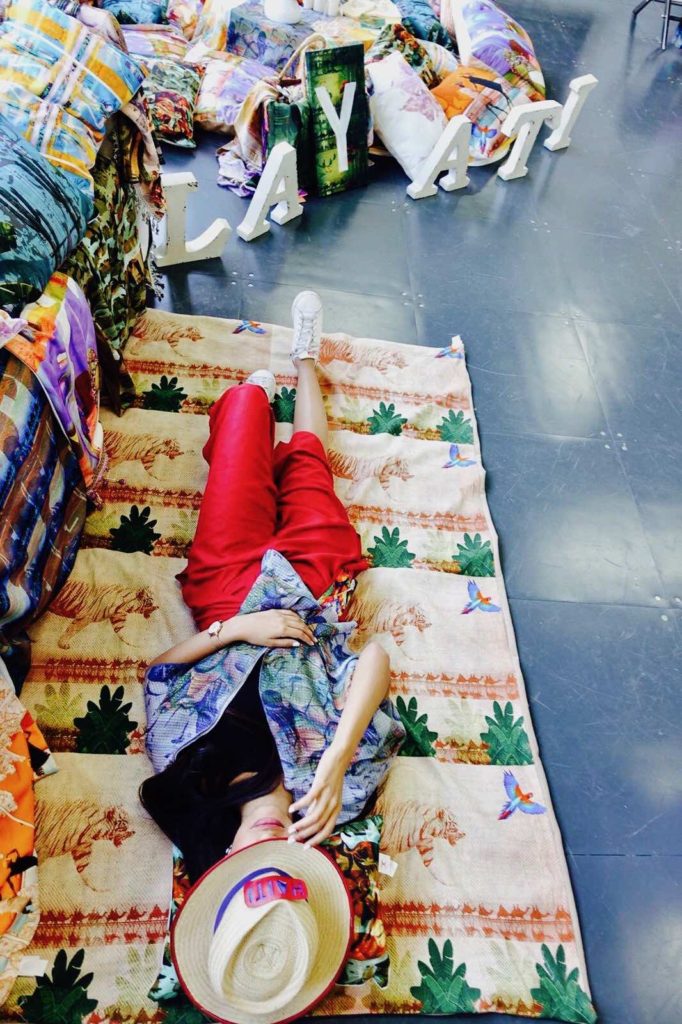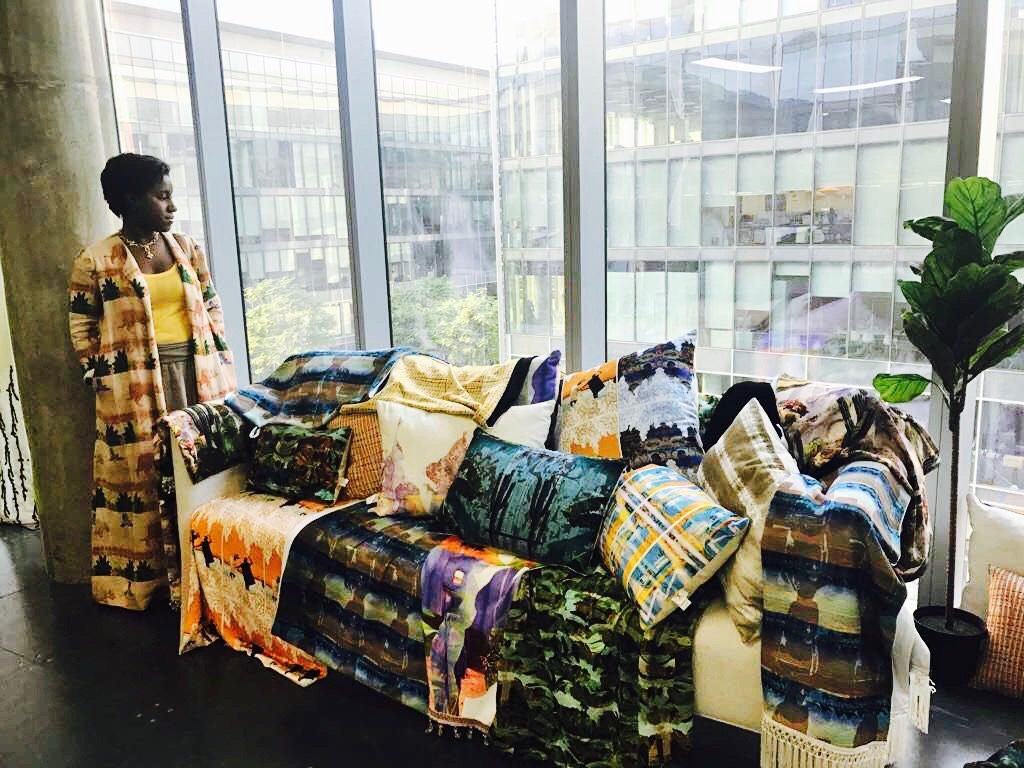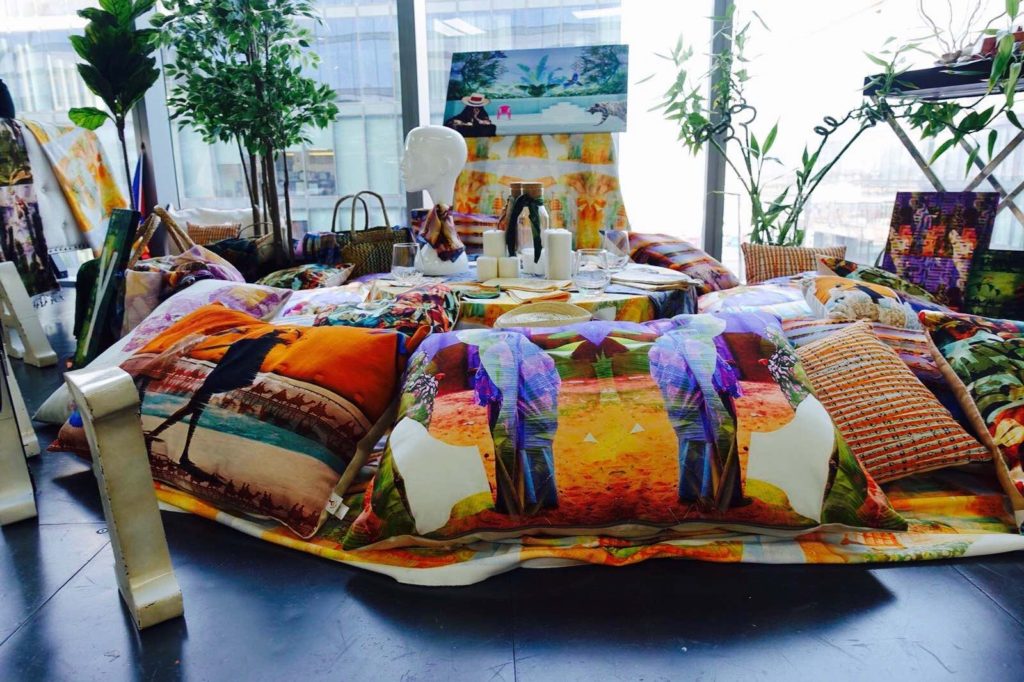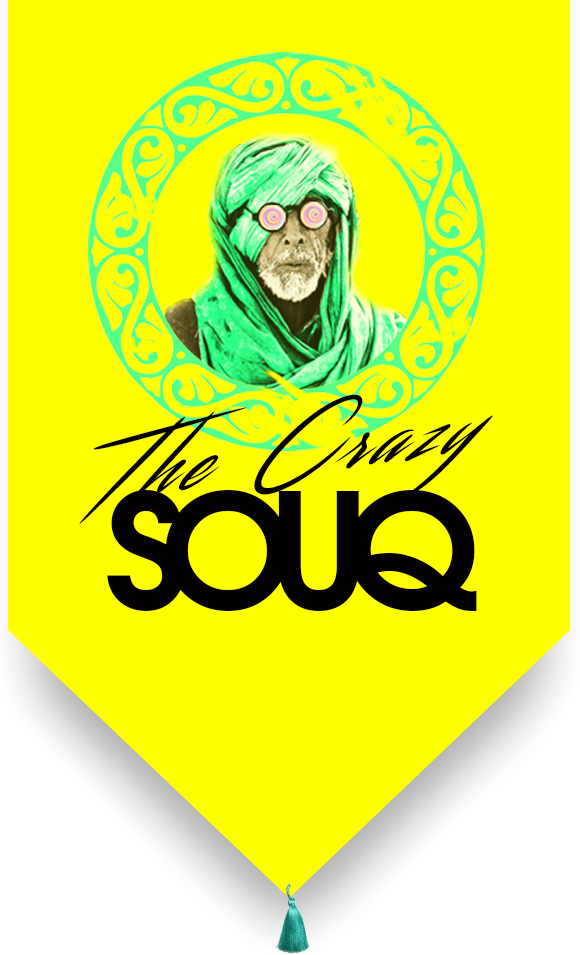L’Ayatï: « Tropical bedouin – A love letter from Haïti to Arabia »
>> Interview by Sihem Lamri
« Haiti and the Middle East are two cultures rich in talent and so little exposed to the rest of the world that I have set the goal to make them shine. »
You should have noticed that TCS is eager to find unexpected encounters. Here is one of a kind: Anne-Isabelle Saint-Pierre, founder and creator of L’Ayatï.
TCS took the opportunity of meeting her during the third edition of the Dubai Design Week. How can you not be charmed by the title of her brand new collection: « Tropical bedouin – A love letter from Haïti to Arabia ».
A Caribbean girl with an Arab soul is how she often defines her mood board in the pursuit of uniting her country with her love for the Middle East. She came from Milan to launch her homewear line in Zaid Farouki’s Atelier. Her universe is set in the room like an island full of colorful and printed linen, tablecloths, scarfs and many other home deco objects. Caribbeans in Dubai.
What is the meaning of L’Ayatï?
Back when I was young, I used to go to summer camps in Europe where I met friends from the Middle East. I was attracted by the Arab culture and by the language. That’s where I first heard the word « habibi, habibi ». I knew it was affective but whereas I was in Haïti Haïti I spoke with a friend from the the UAE and he said « hayati ». I felt an emotional bound even more with this word. So basically L’Ayatï is a mix of « hayati » and « Haïti » with a creole touch. I wanted to create one world out of two. My concern was also to change people’s perceptions about Haïti and the Middle East because at some point I think they both suffer a bad press. Both cultures have so much talent that is rarely seen by the rest of the world and I want to make it my goal to shed light on them. Haïti is not only about earthquakes and poverty. I wanted to testify positivity, my feelings and inspirations, who I am as a person.

What’s your background?
I’ve studied fashion design at the Marangoni Institute in Milan where I specialized in textile and graphic design.
At that time you could tell I was under the influence of Arabic culture when I called my very first collection « Taking the desert by storm ». I’ve also worked with Vivienne Westwood for a fashion week.
In the meantime, writing has always been another part of me so I was a fashion correspondant for the Los Angeles Post and worked along with fashion blogs.
I met Marriam Mossali at Fashion Forward Dubai who founded Niche Arabia and offered me to work for her blog Shoes and Drama. Right after that I decided to create my own brand. So now I’m a master student in communication and media in Marangoni to manage all the process for L’Ayatï.
What are your inspirations?
From what I was surrounded by, my memories, travels, middle eastern culture, scenes of the daily life in Haïti like a woman carrying a basket on her head in the fruit market, nature, animals…I like the idea of a tiger passing by a berber woman in the jungle or a parrot flying over a herd of camels.
I’ve find true inspiration in my family. My grand-father was an artist. My father is a writer, politician and teaches History. My mother is a lawyer and my sister is a writer too. I chose to represent a tree as my logo in the memory of my grand father who used to paint this tree. The narrative is as much important for me as the picture. That’s the reason why I wanted this collection to be « A love letter from Haïti to Arabia », the story of my correspondances with the Middle East from the Caribbeans.

What’s your fabrication process?
The design process is digital painting and afterwards it’s printed on fabric in Milan, Italy. Next it’s manufactured by an Haïtian company in New York. I will give a percentage of the profit to help an orphanage in Haïti preparing for the upcoming Christmas.

Have you thought about a clothing line?
Yes as soon as I will find the right technique to print my design. The abaya I’m wearing is a prototype I made. Lots of women came by my collection and found this abaya cool and funky, asking me to create more. I thought about it from the start but I was afraid of being accused of cultural appropriation. So I’m glad I came here, it has re-opened my conception of the Middle-East and pushed me to come here more often to develop L’Ayatï between Milan and Dubai.
> Exclusive interview by Sihem Lamri for The Crazy Souq
L’Ayatï: « Tropical bedouin – A love letter from Haïti to Arabia »
>> Interview exclusive par Sihem Lamri
« Haïti et le Moyen-Orient sont deux cultures riches de talents et si peu exposées au reste du monde que je me suis fixée l’objectif de les faire briller ».
Il ne vous a pas échappé que TCS aime les rencontres inattendues. En voici une belle: Anne-Isabelle Saint-Pierre, la créatrice de la marque L’Ayatï.
C’est dans le dédale de la 3ème édition de la Dubai Design Week que TCS est allé à la rencontre d’Anne-Isabelle Saint-Pierre, qui aime parfois s’appeler l’Arabe Haïtienne. Le charme opère déjà à l’énoncé de sa collection homewear: « Tropical bedouin – A love letter from Haïti to Arabia ».
Depuis son enfance, Anne-Isabelle rêve de marier son Haïti natal au monde arabe qui la fascine. Fraîchement arrivée de Milan, elle plante le décor de sa toute première collection dans l’atelier de Zaid Farouki. Son univers d’imprimés exotiques prend la forme d’une île dans la pièce. Une variété de coussins, linge de lit, nappes, tableaux, foulards et autres objets vous invitent à une parenthèse caribéenne en plein coeur du Dubai Design District.
Tout d’abord, pourquoi L’Ayatï?
Plus jeune, je participais à des camps d’été en Europe où je me suis liée d’amitié avec des personnes venues du Moyen-Orient. Cela a marqué mon premier contact avec la culture arabe. J’entendais souvent mes amis dire « habibi, habibi ». Je savais que c’était un terme affectif mais alors que j’étais à Haïti, un ami des Emirats a prononcé le mot « hayati » dans une conversation. J’ai senti que « hayati » était encore plus profond et j’entretiens, depuis, une relation très personnelle avec ce mot. J’ai donc choisi L’Ayatï en fusionnant le mot arabe « hayati » et « Haïti » avec une touche créole. Je voulais associer ces deux mondes pour qu’ils deviennent « mon monde ». Je voudrais surtout changer le regard des gens sur mon pays et sur le Moyen-Orient, donner une image positive. Haïti et le Moyen-Orient sont deux cultures riches de talents et si peu exposées au reste du monde que je me suis fixée l’objectif de les faire briller. Haïti ce n’est pas seulement des tremblements de terre, la pauvreté…etc. Je voulais témoigner autre chose, ce que je ressens, mes inspirations, ce que je suis en tant que personne.

Quel a été ton parcours?
Au cours de quatre ans d’études en fashion design à l’institut Marangoni à Milan, j’ai choisi de me spécialiser en textile et graphic design. J’avais appelé ma première collection « Taking the desert by storm ». À cette époque, mes créations étaient déjà influencées par des paysages et des représentations du monde arabe. J’ai aussi préparé une fashion week chez Vivienne Westwood.
J’ai été correspondante mode pour le Los Angeles Post et j’ai travaillé avec les blogs « Fashion To Max » et « Shoes and Drama ». C’est en allant à Fashion Forward à Dubai que j’ai fait la connaissance de Marriam Mossali et travaillé avec elle pour Niche Arabia. À partir de là, j’ai décidé de créer ma marque L’Ayatï et de continuer mes études à Marangoni dans la communication et les médias.
Quelles sont tes influences?
Je m’inspire de mes souvenirs, de voyages, de scènes de la vie quotidienne à Haïti, des marchandes qui marchent dans les rues avec un panier sur la tête, la nature, les animaux… J’aime l’idée qu’une femme berbère côtoie un tigre sorti d’une forêt luxuriante ou qu’un perroquet vole au dessus d’un troupeau de chameaux.
Ma famille m’inspire beaucoup aussi. Mon père est écrivain, politicien et professeur d’histoire, ma mère avocate, ma soeur écrivaine et mon grand-père était peintre. L’arbre du logo de L’Ayatï est d’ailleurs un hommage à mon grand-père qui l’avait peint.
Le récit et l’image ont toujours beaucoup compté pour moi. Malgré la distance, j’ai toujours eu une pensée pour le Moyen-Orient et ressenti cette âme arabe en moi. C’est aussi pour cela que je voulais que cette collection soit une « lettre d’amour d’ Haïti à l’Arabie ».

Comment se déroule la fabrication?
Je m’occupe du design, c’est du digital painting. Le printing se fait à Milan sur des tissus italiens. Puis la production et l’assemblage sont réalisés par une entreprise haïtienne à New-York. Je tiens à ce que 5 à 10% des recettes soit reversé à un orphelinat en Haïti en prévision des fêtes de Noël.

Vas-tu développer une collection de vêtements?
Oui, je n’écarte pas la possibilité. Lorsque je trouverai la meilleure manière d’imprimer mon design sur des vêtements. J’ai créé la abaya que je porte aujourd’hui pour tester l’impression de ce design sur un vêtement. De nombreuses personnes m’ont encouragée à développer cette idée, elles ont trouvé ma abaya cool et funky. J’y avais pensé au départ mais j’avais des craintes par rapport à l’appropriation culturelle. Finalement, cela m’a prouvé le contraire. Cette expérience ici m’a davantage ouverte sur le monde arabe et poussée à venir ici fréquemment pour développer L’Ayatï entre Milan et Dubai.
> Exclusive interview by Sihem Lamri for The Crazy Souq


